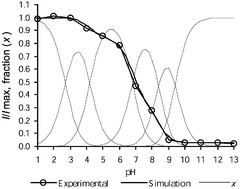Anthrylmethylamines and anthrylmethylazamacrocycles as fluorescent pH sensors—a systematic study of their static and dynamic properties
Abstract
The pH dependent fluorescence of various 9-mono- and 9,10-disubstituded

* Corresponding authors
a
Institut für Chemie, Fachgebiet Physikalische Chemie, Universität Hohenheim, 70593 Stuttgart, Germany
E-mail:
greiner@uni-hohenheim.de
Fax: +7114593881
The pH dependent fluorescence of various 9-mono- and 9,10-disubstituded

 Please wait while we load your content...
Something went wrong. Try again?
Please wait while we load your content...
Something went wrong. Try again?
G. Greiner and I. Maier, J. Chem. Soc., Perkin Trans. 2, 2002, 1005 DOI: 10.1039/B110433K
To request permission to reproduce material from this article, please go to the Copyright Clearance Center request page.
If you are an author contributing to an RSC publication, you do not need to request permission provided correct acknowledgement is given.
If you are the author of this article, you do not need to request permission to reproduce figures and diagrams provided correct acknowledgement is given. If you want to reproduce the whole article in a third-party publication (excluding your thesis/dissertation for which permission is not required) please go to the Copyright Clearance Center request page.
Read more about how to correctly acknowledge RSC content.
 Fetching data from CrossRef.
Fetching data from CrossRef.
This may take some time to load.
Loading related content
